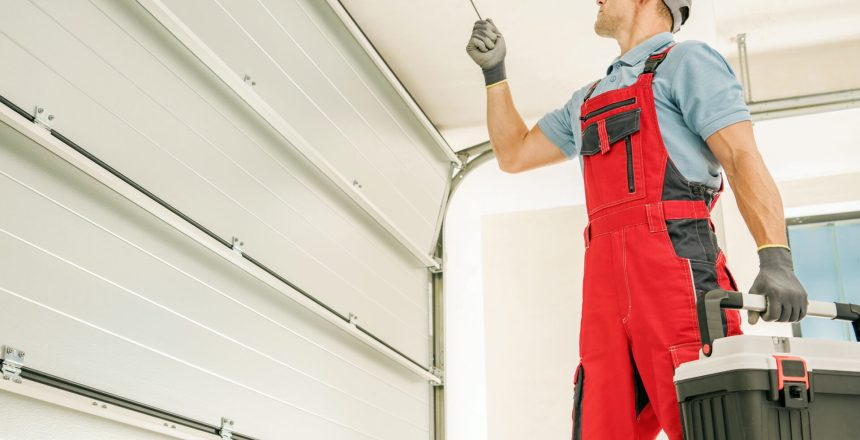Are you a homeowner looking to ensure the safety and functionality of your garage door? Then this step-by-step inspection checklist from Environmental Door is just what you need.
With easy-to-follow instructions, you’ll be able to:
- Assess the balance
- Examine tracks and rollers
- Check springs and cables
- Inspect safety features
- Maintain and lubricate the components of your garage door.
Don’t let potential issues go unnoticed – empower yourself with the knowledge every homeowner should have.
Key Takeaways
- Regular garage door maintenance is essential for reliable performance, preventing costly repairs, improving energy efficiency, extending the door’s lifespan, and increasing home safety and security.
- The garage door should be inspected externally and internally, checking for damage, wear and tear, loose or missing hardware, and proper alignment and balance.
- Safety features such as the auto-reverse function, photoelectric sensors, and emergency release cord should be regularly tested to ensure they function properly.
- Additional maintenance tips include cleaning the door, lubricating moving parts, applying protective coatings, keeping tracks clean, tightening loose screws or bolts, and promptly replacing damaged sections or parts.
Garage Door Checklist 1: Assessing the Garage Door’s Balance
You’ll want to check if your garage door is properly balanced. Garage door alignment plays a crucial role in its smooth operation and longevity. To troubleshoot balance issues, disconnect the opener from the door by pulling the emergency release cord. This will allow you to open and close the door with ease manually.
First, raise the door halfway and let go. If it stays in place, congratulations! Your garage door is well-balanced. However, there may be an imbalance if it starts to fall or rise independently.
Next, you’ll need to test each side of the door separately. Close the garage door completely and secure it in place. Then lift one side of the door about three feet off the ground. Release it gently and observe its behavior. Both sides are balanced if it remains steady or drops slightly before stopping.
Adjustments are needed if one side rises significantly higher than the other or falls quickly when released. Try adjusting the tension spring above each track using a wrench or consult a professional for assistance.
Remember that an imbalanced garage door can cause premature wear and tear on various components, such as springs and cables. It can also strain your opener motor over time.
Regularly assessing your garage door’s balance ensures proper functioning and reduces potential safety hazards. By troubleshooting balance issues promptly, you can save yourself from costly repairs while extending your garage door’s lifespan.
Garage Door Checklist 2: Examining the Tracks and Rollers
First, look at the tracks and rollers of your garage door. Proper maintenance of these components is crucial for the smooth operation of your door. Here’s a troubleshooting guide to help you keep them in top condition:
- Inspect the tracks: Check for any signs of damage or misalignment. Look for dents, bends, or gaps between the sections. If you notice any issues, it’s important to address them promptly to prevent further damage.
- Clean the tracks: Use a soft cloth or brush to remove any debris, dirt, or grease that may have accumulated on the tracks. This will ensure smooth movement and prevent unnecessary strain on the rollers.
- Check for loose hardware: Examine all nuts, bolts, and screws that secure the tracks in place. Tighten any that appear loose to maintain stability.
- Examine the rollers: These small wheels significantly support and guide the garage door as it opens and closes. Look for signs of wear and tear, such as cracks or flat spots on the rollers.
- Lubricate regularly: Apply a silicone-based lubricant to keep your rollers running smoothly. Avoid using oil-based lubricants as they can attract dust and debris.
- Replace damaged rollers: If you notice any significant damage or if they are worn beyond repair, it’s time to replace them with new ones. This will ensure optimal functioning of your garage door system.
Regularly examining and maintaining your garage door’s tracks and rollers is essential to proper garage door maintenance. By following this troubleshooting guide, you can identify potential issues early on and prevent costly repairs.
Garage Door Checklist 3: The Springs and Cables
To ensure the proper functioning of your garage door, it’s important to check the springs and cables regularly. These components are crucial in lifting and lowering your garage door smoothly and safely. Neglecting their maintenance can lead to issues such as malfunctioning doors or accidents. So, let’s take a closer look at how you can inspect these vital parts.
First, evaluate the spring tension by visually examining them for signs of wear or damage. Look out for any gaps in the coils or fraying of the spring wires. Additionally, check if the springs are properly balanced on both sides of the door. An imbalanced spring tension can cause strain on your garage door opener and eventually lead to its failure.
Next, assess the cable condition by checking for any signs of fraying, rust, or loose strands. Damaged cables can compromise the stability and safety of your garage door operation. If you notice any issues with either side of the cable system, it’s crucial to seek professional assistance immediately.
Regularly inspecting these components will help you identify potential problems early on and prevent costly repairs. Remember that vigilance is key to maintaining your garage door’s functionality and safety!
Garage Door Checklist 4: Inspecting the Safety Features
Regularly check the safety features of your garage door to ensure they are functioning properly and providing maximum protection. Your garage door’s safety features play a crucial role in preventing accidents or injuries, so keeping them in good working condition is essential.
Here are some important steps to follow when inspecting the safety features:
- Testing the Garage Door Opener: Check the auto-reverse feature by placing a small object, such as a roll of paper towels, in the door’s path. If the door does not reverse upon contact with the object, there might be an issue with the sensor or opener mechanism. Test the photoelectric sensors by waving a long object, like a broomstick, in front of them while closing the door. The sensors should detect the obstruction and prevent the door from closing.
- Troubleshooting Common Safety Feature Issues: Examine the safety sensor alignment. Clean them carefully if they are misaligned or dirty, and ensure they face each other directly. Inspect the sensor wiring for any damage or loose connections. Replace any frayed wires or tighten loose connections to restore proper functionality.
Remember that these are just basic tests and troubleshooting steps. It is advisable to refer to your garage door opener manual for specific instructions on testing and maintaining its safety features. Regularly inspecting and testing these features will help you identify any issues early on and ensure your garage remains safe for you and your family.
Garage Door Checklist 5: Maintaining and Lubricating the Garage Door Components
Remember, regularly lubricating the various components of your garage door is essential for maintaining smooth and efficient operation. Your garage door opener relies on a system of moving parts to open and close your door safely. By keeping these components properly lubricated, you can prevent wear and tear and extend the lifespan of your opener.
Start by checking the owner’s manual for specific lubrication recommendations. Typically, you’ll need a silicone-based lubricant or white lithium grease. Apply the lubricant to all metal moving parts, such as hinges, rollers, bearings, and springs. Be sure to wipe off any excess oil or grease to avoid attracting dirt and debris.
In addition to lubrication, don’t forget about weatherstripping maintenance. Weatherstripping helps seal gaps between your garage door panels, preventing drafts, moisture, and pests from entering your garage. Over time, weatherstripping can become cracked or worn out.
Inspect the weatherstripping around the edges of your garage door and replace any damaged sections. This will improve energy efficiency and help keep unwanted elements out.
Regularly maintaining and lubricating your garage door components will ensure its reliable performance for years. Don’t wait until something goes wrong – make it a part of your routine home maintenance tasks. By taking care of these small steps now, you can save yourself from costly repairs in the future.
Summary
By following this step-by-step garage door inspection checklist, you can ensure the safety and functionality of your garage door.
Assess the balance, examine the tracks and rollers, check the springs and cables, inspect the safety features, and regularly maintain and lubricate the components.
By doing so, you can prevent potential issues and prolong the lifespan of your garage door.
Keep up with these simple maintenance tasks to keep your garage door operating smoothly for years. Contact Environmental Door for any other questions.


